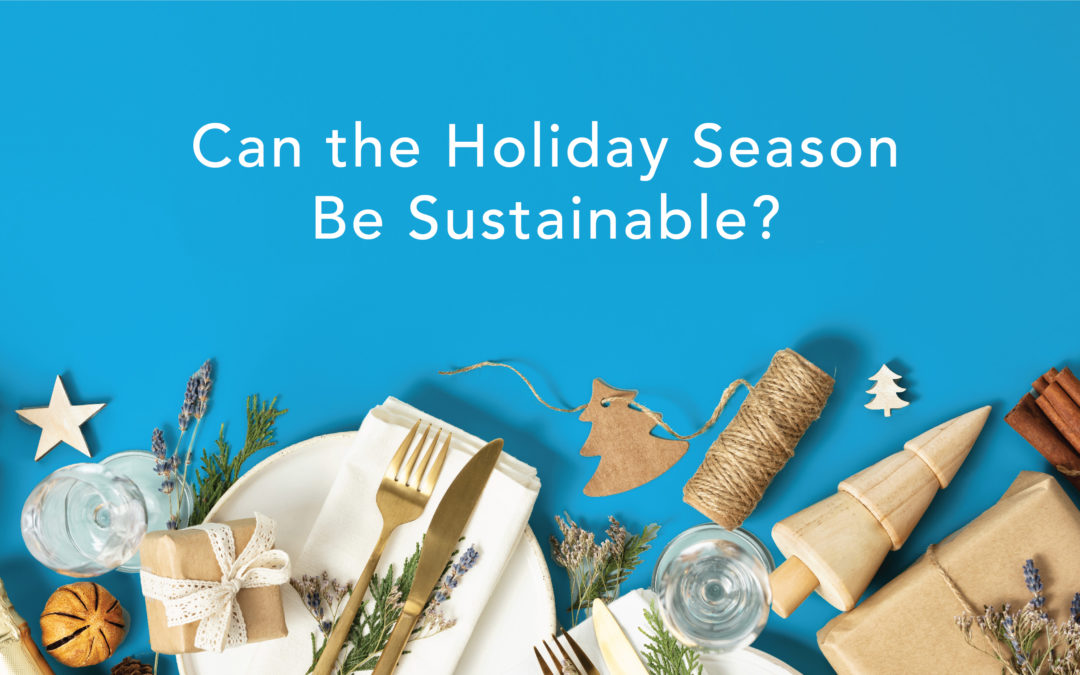The holiday season has arrived! You often hear the phrases; “the best time of the year” or “it’s the most wonderful time of the year!” Unfortunately, whether you are celebrating a winter holiday, hosting festivities, gift-giving, upholding traditions or feasting, the holiday season can be incredibly wasteful. How much waste do we generate while we celebrate? According to Standford University, on average, Americans will throw away 25% more trash during the holidays (between Thanksgiving and New Year) than at any other time of the year, generating approximately 25 million extra tons of garbage. Wrapping paper alone contributes to 2.3 million pounds per year that wind up in landfills! Hold on tight, other alarming holiday facts will be shared in this post that we hope will shift your gift-giving mindset to greener and more sustainable options.
Holiday Fails and Suggestions
Wrapping Paper & Ribbons
Yes, ribbons and bows are also a problem. As mentioned earlier, wrapping paper creates 2.3 million pounds of trash per year and nearly 227,000 miles of it is used in the UK. When it comes to ribbons, we throw away an estimated 38,000 miles worth each year and if each family reused 2 feet of ribbon, it would ultimately save enough ribbons for it to tie a bow around the world!
Pro Tip: When receiving gifts, please make sure to save the ribbons and bows. Reusable cloth ribbons are a better alternative in comparison to single-use plastic bows as well. Try using an alternative methods of wrapping paper – for example, old magazines or colorful newspaper pages to wrap small gifts. Fabrics are also a fun wrapping alternative (watch the video) which are reusable and a could be a gift in itself such as cloth napkins or a scarf. If you prefer to use wrapping paper, make sure it is recycled paper without the shiny plastic coatings, or better yet, when you receive gifts, unwrap the gifts carefully so you can save the wrapping for next year!
Christmas Trees
When it comes to Christmas trees, the US purchases nearly 25-30 million trees annually and an estimated 50 million trees in the UK. There have been debates between fake or real, live or cut. Depending on what type of tree you choose, make sure you make eco-conscious choices.
Pro Tip: If you are cutting a real Christmas tree, be sure to “tree cycle” and please ask your local nursery what trees could be suitable to replant in the area. Artificial trees are a cost-effective alternative option, but they will defeat the purpose if it ends up in a landfill after limited use. It’s best to reuse an artificial tree for at least 10 years to be sustainable. A live Christmas tree that can be planted after use is the best option. Plant it in your backyard and use it again next year, here’s how.
Lights
Once we install those twinkling lights, we instantly get into the holiday spirit. However, it is estimated consumers throw away nearly 500 tons of Christmas lights each year. The impact on energy consumption is enormous as well. Each year, it is estimated to be equal to powering 400,000 homes!
Pro Tip: Turn off the holiday lights when you go to bed and use LED lights to save energy. The simple switch to LED consumes 75% less energy than traditional lights. Not only do LED lights use less energy, but they will also last 25 times longer than traditional lighting (10 – 20 years) and they look just as good!
Food Waste
The holiday parties are filled with loads of food and treats but it also comes with a lot of food waste. Over “70 billion pounds of food waste reaches our landfills every year, contributing to methane emissions and wasted energy and resources across the food supply chain”. The holidays are the worst culprit with a rise of 25% more food waste than the rest of the year, mainly due to uneaten leftover and unsold food from supermarkets.
Pro Tip: Plan ahead with your family and friends to coordinate how much food is necessary to avoid any uneaten leftovers. If you do have to throw anything away, compost. Composting is critical for the health of our planet in a variety of ways.
Using compostable serviceware is also proven to hep divert food waste into compost bins as well – no sorting! When you can’t use reusable plates, cutlery and cups, look for compostable single-use items instead of plastic or paper options that contain harmful toxic chemicals.
In addition, buying locally sourced and seasonal ingredients can reduce your carbon footprint.
Simple changes can have a huge impact to our environment and your community. Don’t be a Scrooge to the planet this season so we can keep the holiday spirit alive for generations to come.

